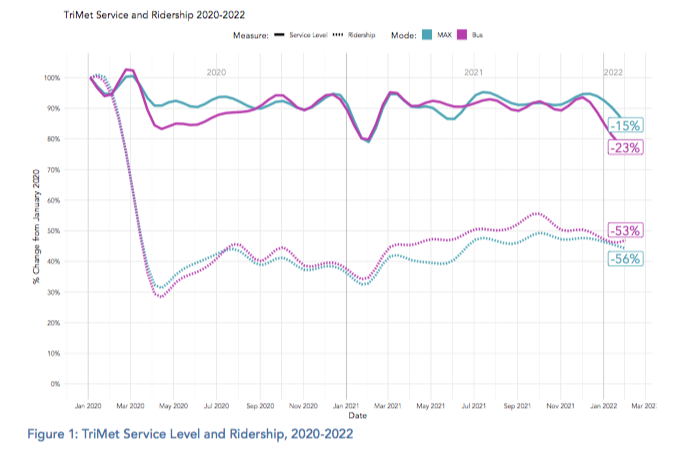
With all those trees in the way, it can be really easy to miss the forest. So, last week, when TriMet released its Forward Together Draft Service Concept, many people, myself included, made a beeline to our neighborhood bus, and then immersed ourselves in the tangle of other nearby routes
Meanwhile, staring the reader in the face, and probably going unnoticed, was the fact that TriMet did not write this report. The document was the work of the Jarrett Walker + Associates, a Portland-based transit consulting company with a long list of clients from around the world.
But even if you missed the name, the tone of the writing was a tip-off. This document was different from the usual TriMet work product, and the consultants have brought a fresh eye and frankness to the project of a post-pandemic reorganization of TriMet service.
In Portland: Turning the Dial Toward Equity (How Far?), a recent blog entry on the firm’s website, Jarrett Walker himself talks about their TriMet project and the questions about what future service should look like. He asks, “And as we look at how much to invest in equity, we have a big question for the community to think about: How much redistribution of service toward lower-income areas should we do?” He then introduces the reader to trade-offs to consider, and makes the point that
The Service Concept we’ve released is just that, a concept. It is not even a proposal, and it’s certainly not a recommendation. We are not saying that we have it right. We are putting it out there to start a conversation.
Toward that end, TriMet has a short survey they would like you to take, and also several open houses this month.
In addition to the primary report, there are a couple of documents which will interest readers who want a deeper understanding of Portland’s transit challenges.
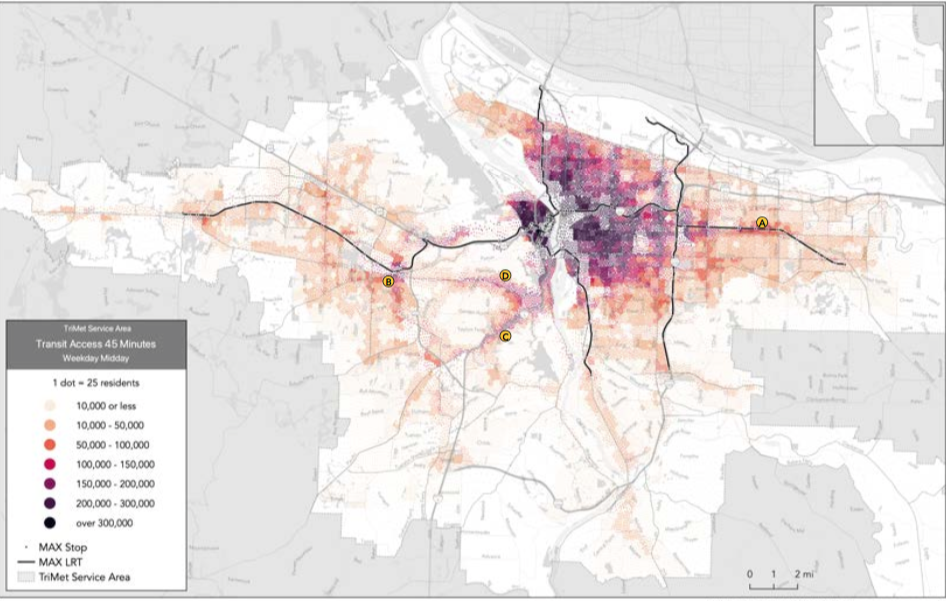
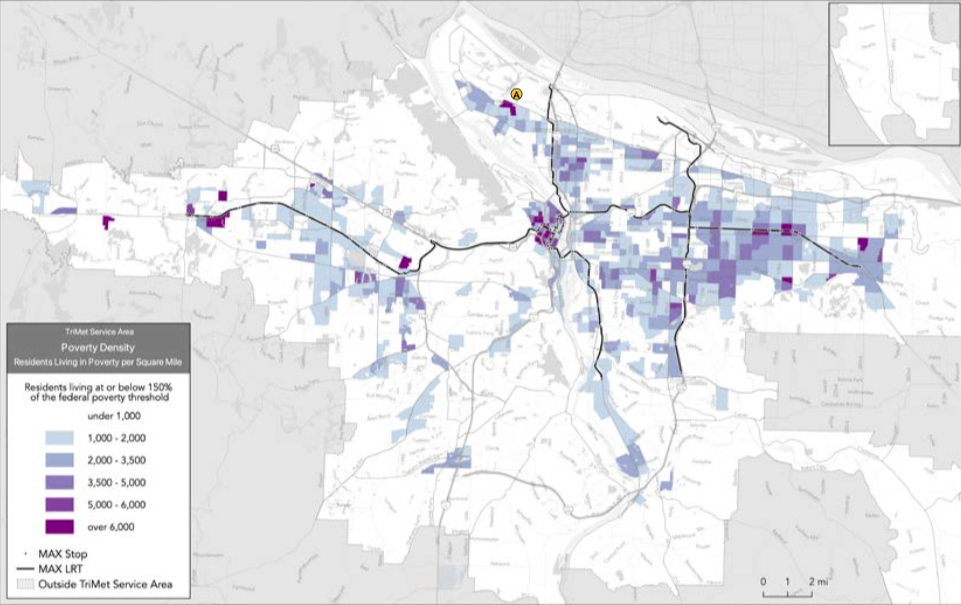
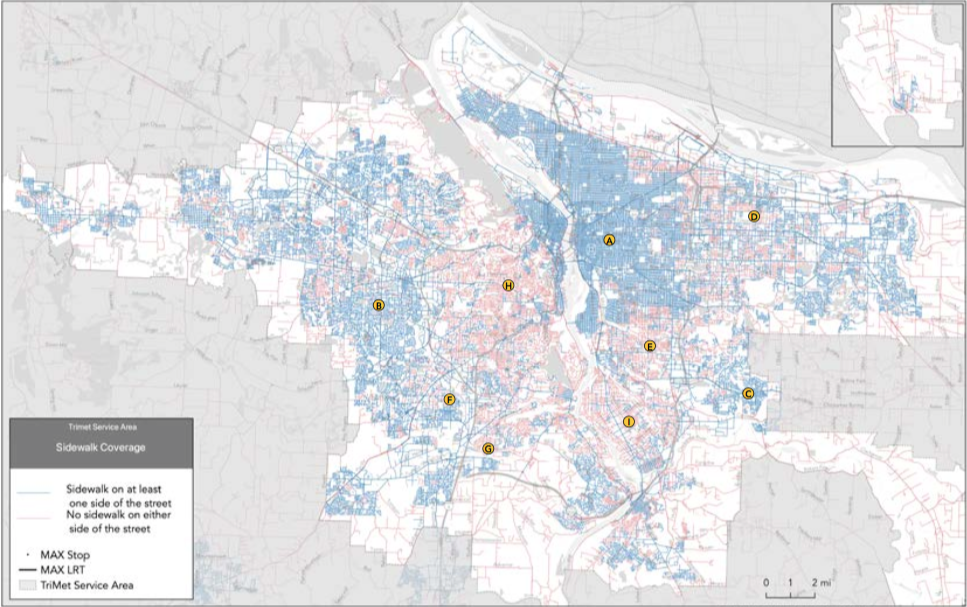
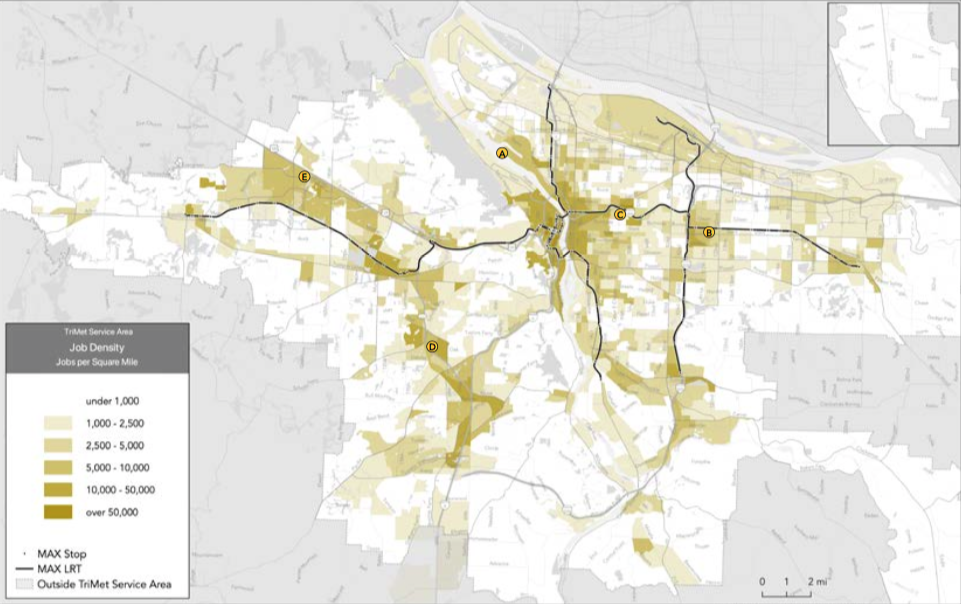
The Transit Existing Conditions Report is an incredible resource. It begins as a primer on transportation networks, and includes explanations of basic principles like the Ridership/Coverage trade-off. About a quarter of the way in, though, the document transforms into a fantastic book of maps. Even if you don’t want to read anything, scroll through them. Above are a few.
The Technical Memorandum from the Portland-based Parametrix consultants organizes transit trends into two time periods, before and after the pandemic, and also compares trends in Portland to regional and national trends. They look at gentrification, ride hailing services, congestion, road safety, driver shortages and declining transit ridership. Much of this will not be completely new information for readers who follow transportation news closely, but it was helpful to have all of it in one place, concisely reported, and with the local to national comparisons. Also, they cite sources, with links, which makes this report a valuable resource.
One fun tidbit was the local working trends by employer, compiled from employers surveyed in February and March, 2022 (pages 15-17). At Kaiser Permanente, 95% of administration was working from home; OHSU had 55% of employees working remotely; and at PGE 65% were remote. It also touched on the issues of safety, adopted driving habits and hybrid schedules.
In short, if you love the Portland area and are a transit nerd, these documents are a treasure-trove.



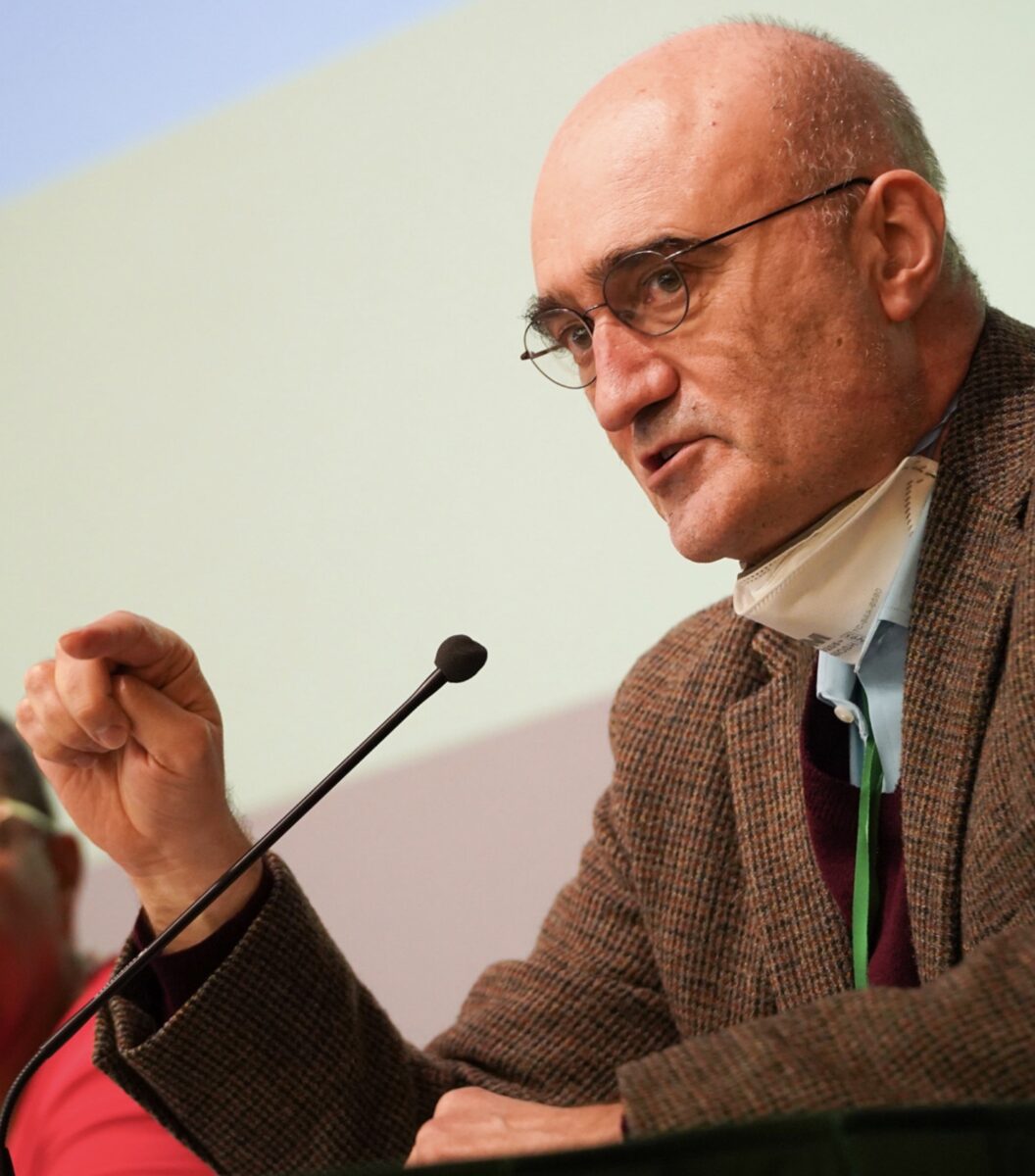
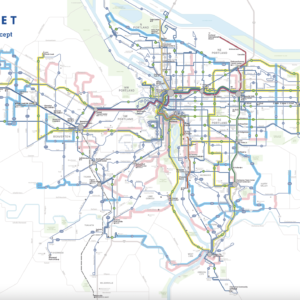
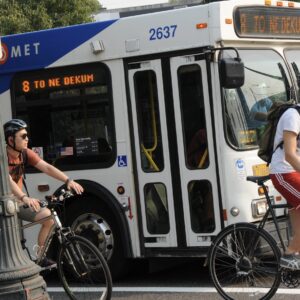
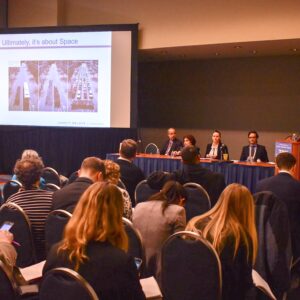
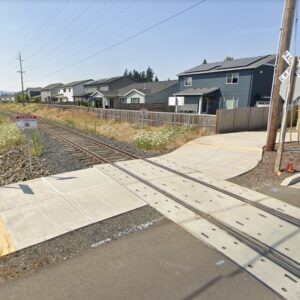
Thanks for reading.
BikePortland has served this community with independent community journalism since 2005. We rely on subscriptions from readers like you to survive. Your financial support is vital in keeping this valuable resource alive and well.
Please subscribe today to strengthen and expand our work.
Any amount of service realignment isn’t going to address the far bigger problem: every 15 minutes simply isn’t frequent service. Frequent service buses, MAX, and streetcar should be run at every 8 to 12 minutes depending on the route. I don’t see the point of suburban expansion when TriMet isn’t even providing a compelling service in high ridership areas.
Absolutely. Let’s improve transit service for the people who already ride it before we try to entice people out of their cars.
There’s definitely some bottlenecks in the system though. One that comes to mind is the steel bridge. All the MAX lines go across it and they go so slow that I don’t think it’s possible for them to run more frequent trains. If they wanted to up overall MAX frequency, they’d probably have to build a new bridge first. Maybe a good stopgap would be running blue line trains that turn around at the Rose Quarter. They could do something similar with the Orange/Yellow line, with more frequent trains from expo to the Rose Quarter.
I imagine the Tillikum bridge would cause a headache too, because it currently has streetcar, MAX, and three bus lines running across it.
The Steel Bridge has been on my mind for a while. It’s the little picture in the margin next to the word “bottleneck” in the dictionary. (Sorry, I’m a certain age and have an ink-on-paper fetish.)
Could light rail trips across the river be optimized by reversing some trains and running a shuttle bus loop on surface streets to transfer riders who want to cross town anyway?
In my mind that creates more problems than it solves. You add frequency, yes. But you also introduce complications to the system as a whole. Operators need to physically walk to the other end of the train, and when you’re talking about adding higher frequency, a stoped train could cause issues for trains behind it, or coming from the other direction when they switch sides.
For riders, it becomes a less intuitive system. If I hop on a Green Line at Gateway I know that (baring something unusual) it will take me downtown. In this system I might have to make a transfer anyway, so why not wait for a train that does? This is exactly the problem that the Westbound trains on the Red/Blue lines had during rush hour. People who are going past Beaverton wouldn’t bother getting on a Red Line train, meaning that you’d have standing room only Blue Line trains running behind Red Line trains that had plenty of room.
Also, there would be a huge operational cost in trying to run shuttle buses for MAX replacement.
A better option is to build the proposed downtown MAX tunnel: https://www.oregonmetro.gov/max-tunnel-study
Or run early enough or late enough. Not everyone works 8-5.
Look at the top graph: TriMet’s fundamental problem is the yawning gap between the solid lines and dotted lines. Moving the service line up won’t necessarily impact the ridership line if the reasons people with alternatives have largely abandoned TriMet aren’t addressed.
TriMet is solving the wrong problem here.
Watts, have you looked at the report?
No, but the tone of your comment suggests I should. I thought this was the same report I saw described earlier suggesting service and coverage improvements, and followed on from the TriMet survey I took recently that primarily addressed the same.
The fundamental problem I see is that TriMet’s core service model is increasingly out of step with the way people travel. The more immediate issue is safety and comfort (and, perhaps for some, service frequency). But addressing these immediate issues (which I’ve seen no evidence TriMet is willing or able to do) does not address the fundamental disconnect between the type of service people want and what TriMet can provide.
I’ll take a closer look at the report and see if my understanding of it is wrong.
Thanks for your reporting!
Hi Watts, I link to two other reports half way through the article , the technical memo and the existing conditions. Those are the documents that might interest you. I think they show that, indeed, the transportation planners have a grasp on “how people travel.”
You’re right — the technical memo is a particularly interesting document.
But I believe my concern still stands. With the exception of a few bullet points near the end (microtransit, rideshare. mobility hubs), most of the proposed solutions are some combination of “more coverage” and “higher frequency”, and while those may help at the margins, they’re expensive to provide and will be hard to justify without a massive increase in ridership. And they miss the point.
For discretionary trips (i.e. not the sort of routine 9-5 commuting that WFH has eaten into, especially downtown where all the buses go), I believe that most people don’t want to travel on a fixed route/fixed schedule; they want the flexibility to travel point-to-point on demand, often with the ability to carry stuff, ideally protected from the weather and with a feeling of security.
Transportation is facing a revolution in the coming years. How will TriMet fare?
This seems like great incremental changes that will not solve the underlying problems. As the report itself admits, busing is for the poor. Why would anyone with money take the bus when they ride in their car? Anywhere that they go, they’ll get there so much faster, plus enjoy the benefit of transportation that is always available and useful for taking long trips.
Places where people actually want to use public transportation are places where it is MORE convenient to take light rail, train, bus or subway. As long as these patchwork solutions don’t consider taking away car lanes, their effectiveness will be limited.
Portland should have had MAX lines going through inner-SE and going along or through the central city so that not all those have to go slowly through downtown.
Fast buses should have gone through wider streets than Division and more importantly, take up one lane of ALL highways so that people busing can actually get FASTER to work on a bus.
We should have taken Powell Blvd away from Oregon Department of Trucks YEARS ago! Then maybe the new BRT line could have run along there instead of Division, which was bonkers.